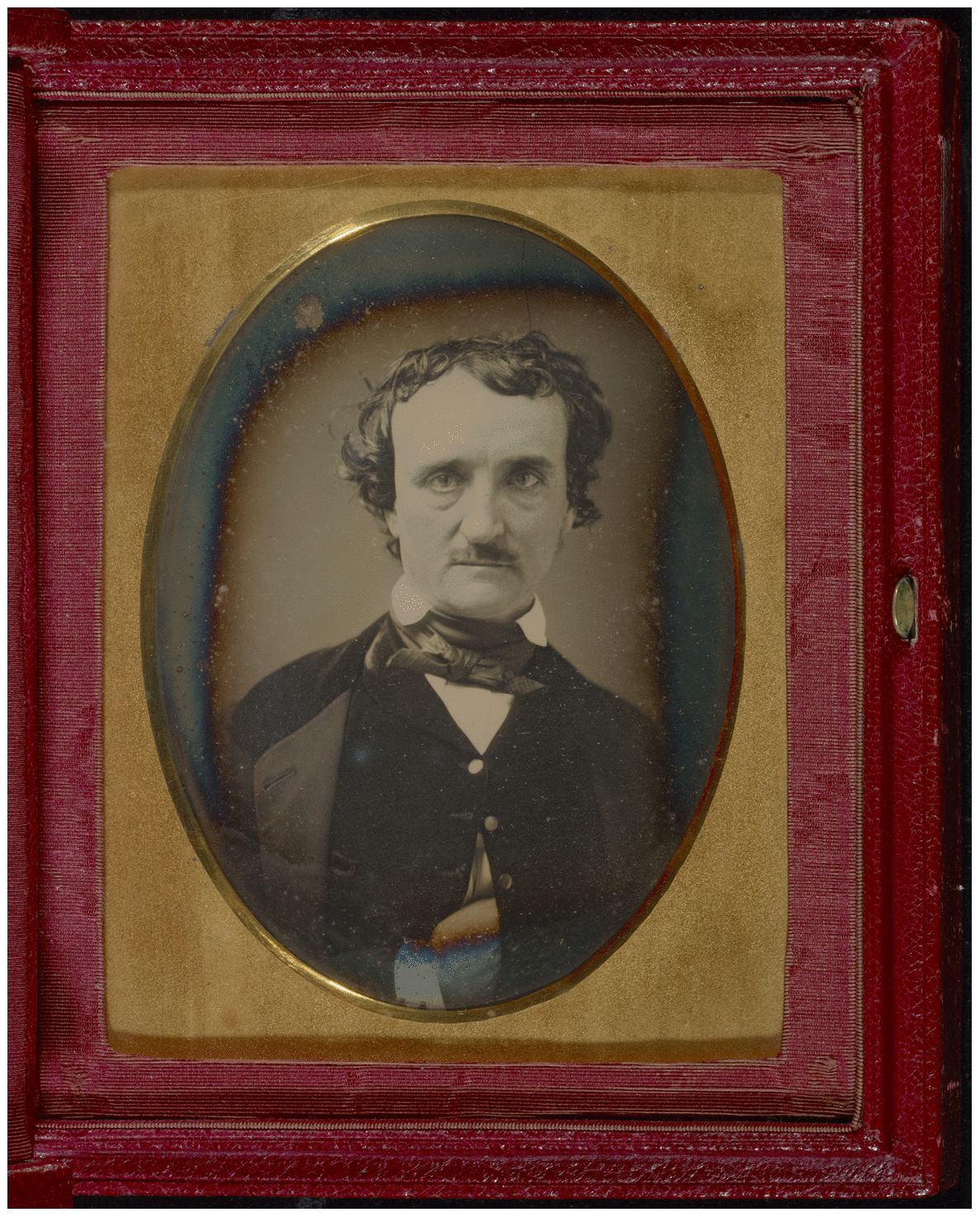It is a theorem almost demonstrated, that the consequences of any new scientific invention will, at the present day exceed, by very much, the wildest expectations of the most imaginative.
The Daguerreotype by Edgar Allan Poe, 1840
 FIGURE 1 Unknown maker, American, Portrait of Edgar Allan Poe, late May–early June 1849, Daguerreotype, 12.2 × 8.9 cm (4 13/16 × 3 1/2 in.). The J. Paul Getty Museum, Los Angeles.
FIGURE 1 Unknown maker, American, Portrait of Edgar Allan Poe, late May–early June 1849, Daguerreotype, 12.2 × 8.9 cm (4 13/16 × 3 1/2 in.). The J. Paul Getty Museum, Los Angeles.
Joan Severa has observed that daguerreotypes “almost seem to breathe.” Photographic portraits are indeed compelling and in some ways perplexing in their inherent contradictions. Uncanny as defined by Freud, the photograph is both familiar and foreign. As cultural theorists tell us, a photograph is both a depiction of reality (both the sitter and the photographer were physically present) and an interpretation of reality. The photograph is an artifact of life and death and memory for Roland Barthes. The photograph reveals a personal identity, but, as Pierre Bourdieu reminds us, is wrapped up in class ethos. The photographic portrait captures the image of a real person, but Susan Sontag warns us that photographs are actually manipulative, turning people into objects.
The three essays in this issue are concerned with the photographs of people. Rather than viewing photographic portraits as manipulation by the medium or the photographer, each of the articles gives agency to the subjects, showing how they constructed their own identity through their choice of clothing and deportment. M. Elaine MacKay’s careful analysis of ten daguerreotypes from early Canada reveals how the female sitters fashioned their appearance through choices in bodice style and accessories such as collars, handkerchiefs, and mittens. These choices indicate how the sitters used dress as expressions of both personal and social identity. Beatriz Bastarrica Mora bases her study on a unique “Register of Domestics” that recorded photographs and descriptions of 2,350 female domestic workers in Guadalajara, Mexico, between 1888 and 1894. The author shows how the working-class women presented themselves to both fit into their social class and to transcend it.
As these two articles show, the development of photography in the nineteenth century was a harbinger of populist appropriation of images and the advance of modernism. Kevin Whiteneir brings us fast forward to the post-modern age with his analysis of still and moving images of Prince, in which the musician used sexualized flamboyant costume and movement to subvert cultural meta-narratives.
Each of the articles in this issue is about the photographic image, but also about gender. The sitters in MacKay’s daguerreotypes of middle-class adolescents, wives, and mothers, and Mora’s photographs of female domestics, give visual voice to women often relegated to the sidelines. The portraits both performed and, in some cases, defied gender expectations. Prince, in Whiteneir’s essay, constructed his image to subvert gender and challenge social perceptions of masculinity.
As dress scholars, we have a particular relationship with photographic portraits. We are comfortable using them as evidence; we just love to scrutinize every tiny millimeter across their surfaces. We analyze how subjects dressed for their portraits for the practical and essential purposes of identification and dating; and also for critical understanding of the visual construction of identity. Photographs no doubt will continue to be fundamental to our work on dress of the nineteenth century to the present.
I am pleased to say that in the last few issues, the articles in Dress have escaped North America both geographically and chronologically. We have now seen medieval Spanish boots, Panamanian Kuna blouses, and seventeenth-century French fontanges. I welcome contributions to knowledge about dress and adornment from across the globe. I also would like to encourage submissions for Research Reports: shorter essays that focus on a particular aspect of a larger project, or on a particular research resource, such as an archival or artifact collection. Reports provide an opportunity to share with readers work in progress and sometimes to pose questions. I also hope to see forums or viewpoint papers that explore the state of dress scholarship today, whether presented as case studies or philosophical musings.
I hope you enjoy the photographic portraits of people in this issue—from colonial matrons to pop stars. Although they are worlds apart, they are on a continuum, and remind me of a cartoon I saw recently of a top-hatted man holding a big box camera pointed at his face. The cartoon was entitled “Daguerre takes a selfie.”
Editor-in-Chief
